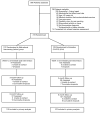Research to encourage exercise for fibromyalgia (REEF): use of motivational interviewing, outcomes from a randomized-controlled trial
- PMID: 23042474
- PMCID: PMC3541460
- DOI: 10.1097/AJP.0b013e318254ac76
Research to encourage exercise for fibromyalgia (REEF): use of motivational interviewing, outcomes from a randomized-controlled trial
Abstract
Objectives: Regular exercise is associated with important benefits in patients with fibromyalgia (FM). Unfortunately, long-term maintenance of exercise after a structured program is rare. The present study tested the efficacy of Motivational Interviewing (MI) to promote exercise and improve symptoms in patients with FM.
Methods: A total of 216 patients with FM were randomized to 6 MI sessions (n=107) or an equal number of FM self-management lessons (education control/EC, n=109). Co-primary endpoints were an increase of 30 minutes in moderate-vigorous physical activity and improvement in the Fibromyalgia Impact Questionnaire (FIQ)-Physical Impairment score, assessed at pretreatment, posttreatment, and 3-month and 6-month follow-up. Secondary outcomes included clinically meaningful improvements in FIQ score, pain severity ratings, and a 6-minute walk test.
Results: There were no significant treatment group differences in either co-primary endpoint at 6-month follow-up. However, more MI participants than controls exhibited meaningful improvements in FIQ score at 6-month follow-up (62.9% vs. 49.5%, P=0.06). Compared with EC participants, MI participants also displayed a larger increment in their 6-minute walk test (43.9 vs. 24.8 m, P=0.03). In addition, MI was superior to EC in increasing the number of hours of physical activity immediately postintervention and in reducing pain severity both immediately after the intervention and at 3-month follow-up.
Conclusions: Despite a lack of benefits on long-term outcome, MI seems to have short-term benefits with respect to self-report physical activity and clinical outcomes. This is the first study in FM that explicitly addresses exercise maintenance as a primary aim.
Trial registration: ClinicalTrials.gov NCT00573612.
Conflict of interest statement
No conflicts of interest to declare
References
-
- Wolfe F, Ross K, Anderson J, et al. The prevalence and characteristics of fibromyalgia in the general population. Arthritis Rheum. 1995;38:19–28. - PubMed
-
- Winkelmann A, Perrot S, Schaefer C, et al. Impact of fibromyalgia severity on health economic costs: results from a European cross-sectional study. Appl Health Econ Health Policy. 2011;9:125–36. - PubMed
-
- Lachaine J, Beauchemin C, Landry PA. Clinical and economic characteristics of patients with fibromyalgia syndrome. Clin J Pain. 2010;26:284–90. - PubMed
-
- Busch AJ, Thille P, Barber KA, et al. Best practice: E-Model--prescribing physical activity and exercise for individuals with fibromyalgia. Physiother Theory Pract. 2008;24:151–66. - PubMed
-
- Gowans SE, Dehueck A, Voss S, et al. Six-month and one-year followup of 23 weeks of aerobic exercise for individuals with fibromyalgia. Arthritis Rheum. 2004;51:890–8. - PubMed
Publication types
MeSH terms
Associated data
Grants and funding
LinkOut - more resources
Full Text Sources
Other Literature Sources
Medical


